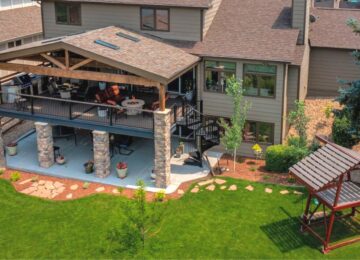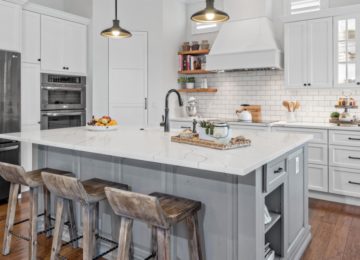Floor lamps are tall, freestanding lighting fixtures designed to provide ambient or task lighting in a room. They typically consist of a base that rests on the floor, a pole or stand that extends upward, and a lampshade or light fixture at the top. Floor lamps come in various styles, shapes, and sizes, making them versatile additions to home decor.
Here are some critical components of floor lamps:
- Base: The base is the bottom part of the floor lamp that provides stability and support. It is designed to sit on the floor and may come in various materials such as metal, wood, or stone.
- Pole or Stand: The pole or stand extends from the base and supports the lampshade or light fixture at the top. This part of the floor lamp can be straight or curved and may have additional features like adjustable height or swivel mechanisms.
- Lampshade or Light Fixture: The lampshade or light fixture is the uppermost part of the floor lamp and houses the light source. Lampshades come in different shapes and materials and serve both functional and aesthetic purposes. Some floor lamps have exposed light bulbs without a shade for a more industrial or minimalist look.
- Light Source: Most floor lamps use incandescent, LED, or CFL bulbs as a light source. The type of bulb and its wattage can impact the brightness and colour temperature of the light emitted by the floor lamp.
- Switch or Controls: Floor lamps typically have an integrated switch or control mechanism for turning the light on and off. Some may also feature dimmer switches or remote controls for adjusting the brightness level.
Floor lamps are mainly used in living rooms, bedrooms, offices, or any space where additional lighting is needed. They are famous for providing indirect or ambient lighting, and their versatile designs allow them to complement various interior styles.
Advantages and Disadvantages of Floor Lamps: –
Advantages of Floor Lamps:
- Versatility: Floor lamps come in various styles, sizes, and designs, making them beautiful additions to any room. Whether you need ambient lighting, task lighting, or accent lighting, there’s likely a floor lamp that fits your needs.
- Portability: Unlike fixed lighting fixtures, floor lamps are portable. You can quickly move them around the room to change the lighting arrangement or provide illumination in different areas.
- Space-saving: Floor lamps take up vertical rather than horizontal space, making them suitable for smaller rooms with limited floor space. You can place them in corners or alongside furniture without occupying valuable tabletop space.
- Aesthetic Appeal: Floor lamps can serve as decorative elements in a room, contributing to the overall aesthetic. They come in various materials, finishes, and styles, allowing you to choose a floor lamp that complements your interior design.
- Task Lighting: Many floor lamps are designed to provide focused task lighting, making them useful for reading, writing, or working on a specific task. Adjustable or articulating features enhance their functionality.
Disadvantages of Floor Lamps:
- Occupies Floor Space: While floor lamps save horizontal space, they do occupy floor space, and in smaller rooms, this can be a limitation. It’s essential to consider the available floor space and the lamp’s size to avoid crowding.
- Limited Ambient Lighting: While floor lamps are excellent for task lighting, they may not always provide sufficient ambient lighting. Additional lighting sources, such as ceiling fixtures or table lamps, may be needed for a well-lit room.
- Top-Heavy Design: Some floor lamps have a top-heavy design, making them more prone to tipping over. This is especially important to consider in households with pets or small children.
- Cord Management: The power cord of a floor lamp can be a visual distraction and may need to be managed to avoid tripping hazards. Some floor lamps come with cord management features, but it’s a factor to consider.
- Cost: Depending on the design, material, and brand, floor lamps can be relatively expensive compared to other lighting options. Higher-end or designer floor lamps may come with a higher price tag.
In summary, while floor lamps offer versatility and aesthetic appeal, it’s essential to consider factors such as available space, lighting needs, and safety concerns when deciding if they are the right lighting solution for a particular room.
5 Modern Designs for Home Floor Lamps
- Gold Arc Floor Lamp- The Gold Arc Floor Lamp is designed with versatility, making it an ideal asset to living rooms, bedrooms, or office spaces. The timeless appeal of the gold finish effortlessly complements various interior styles, from modern and minimalist to classic and eclectic.
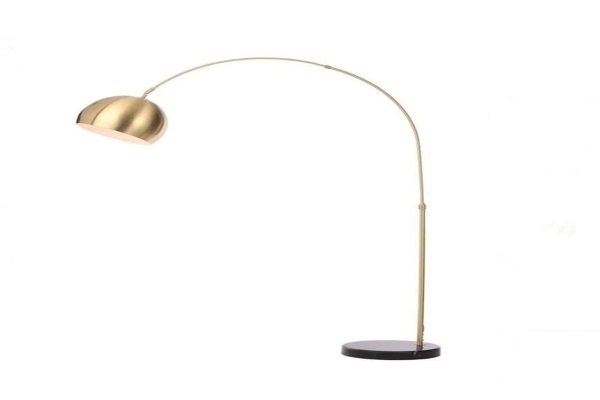
- Silver Arc Floor Lamp- The Silver Arc Floor Lamp with an customizable arm and shade, allowing you to direct light exactly where you need it. Whether creating a cosy reading nook or enhancing the ambience in your living space, this lamp is a perfect choice. The sturdy base ensures stability, while the silver-toned metal construction adds a touch of glamour to your home decor.
- Nelson Gold LED Floor Lamp- Introducing our Gold LED Floor Lamp– a radiant addition to your home decor that seamlessly combines modern aesthetics with energy-efficient functionality. This exquisite floor lamp boasts a luxurious gold finish, elevating your space with opulence. Its sleek design effortlessly enhances any room, making it a versatile and stylish lighting solution.
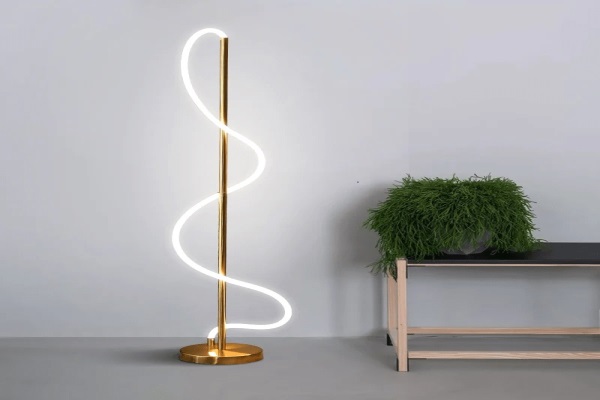
- Camilo Gold Floor Lamp- Introducing the Camilo Gold Floor Lamp – a beacon of elegance and sophistication for your living space. This exquisite floor lamp is a testament to timeless design, featuring a lustrous gold finish that effortlessly radiates luxury. With its captivating silhouette, the Camilo Gold Floor Lamp is a focal point, adding a touch of glamour to any room.
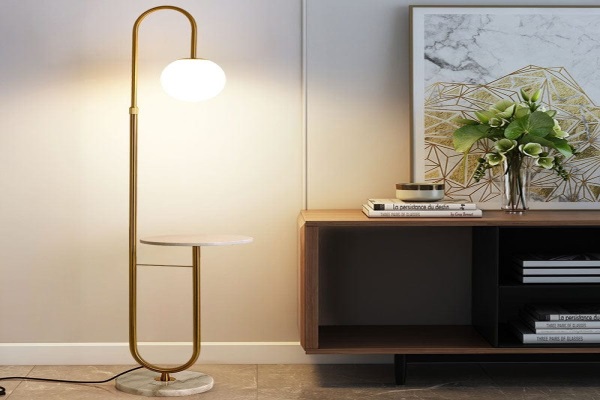
- Tison Black Tripod Floor Lamp- Introducing the Tison Black Tripod Floor Lamp – a sleek, modern lighting solution that effortlessly combines functionality with contemporary design. This eye-catching floor lamp features a minimalist yet bold black tripod base, adding a touch of understated elegance to your living space.
How do you incorporate living room floor lamps the right way?
Incorporating living room floor lamps can significantly enhance the ambience and functionality of your space when done thoughtfully.
Here are some tips on how to incorporate floor lamps into your living room the right way:
- Consider the Room Layout: Assess the layout of your living room to determine the best placement for the floor lamp. Consider areas that may benefit from additional lighting, such as reading nooks or corners.
- Balance with Other Lighting: Ensure a balanced lighting scheme by combining floor lamps with other light sources, such as overhead fixtures and table lamps. This helps create a layered and inviting atmosphere.
- Choose the Right Style: Select a floor lamp that complements the overall style of your living room. Whether it’s a modern arc lamp, a classic torchiere, or a sleek tripod design, make sure it harmonizes with your existing furniture and decor.
- Mind the Scale: Consider the size of your living room when choosing a floor lamp. A large room may accommodate a taller or more substantial lamp. At the same time, a smaller space may benefit from a more compact design to avoid overwhelming the area.
- Focus on Functionality:
- Determine the primary function of the floor lamp.
- If it’s for reading or task lighting, select a lamp with an adjustable head or arm.
- If it’s for ambient lighting, consider a lamp with a soft, diffused shade.
- Coordinate Colors: Pay attention to colour coordination. Ensure that the colour of the floor lamp complements with the existing colour scheme in your living room. A well-chosen colour can add visual interest to the space.
- Create Visual Interest: Use the floor lamp as a design element to create visual interest. A unique or stylish floor lamp can be a focal point in the room, drawing attention and adding personality to the space.
- Hide Cords: Conceal cords to maintain a clean and organized look. Use cord organizers, rugs, or furniture to hide and manage cords effectively.
- Add Dimmer Controls: Consider floor lamps with dimmer controls or use smart bulbs to adjust the lighting intensity. This allows you to create different moods and adapt the lighting to various activities.
- Experiment with Placement: Feel free to experiment with the placement of floor lamps. Move them around until you find the optimal position that maximizes functionality and aesthetics.
By carefully considering these aspects, you can incorporate living room floor lamps in a way that enhances your space’s style and functionality.
To know about light store, please visit our website: mafeemushkil.com


